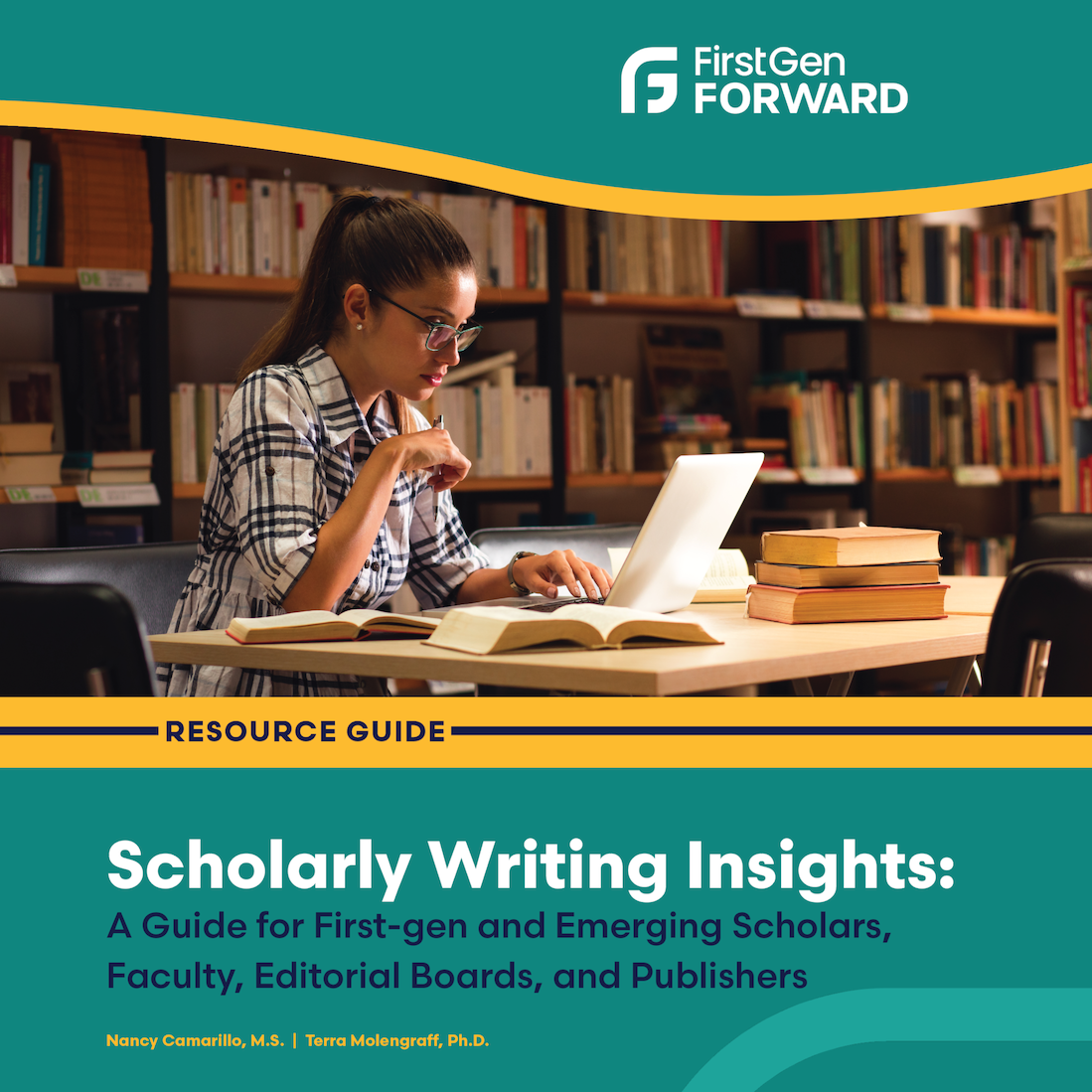Resource Guides
Resource Guides

NEW RESOURCE GUIDE!
Prioritizing First-generation Students in Online Education
Online education has become a crucial pathway for first-generation students, who appreciate the adaptability while often balancing work, family, and other responsibilities. And, contrary to earlier assumptions, online education appeals to traditional-aged students as well. This resource guide from FirstGen Forward provides recommendations for those seeking to make online education a meaningful educational experience for first-generation students, focusing on their success and engagement in this modality.
NEW RESOURCE GUIDE!
Scholarly Writing Insights:
A Guide for First-gen and Emerging Scholars, Faculty, Editorial Boards, and Publishers
Understanding the scholarly writing process is essential for first-generation students and emerging scholars who have been excluded from academic spaces. Gatekeeping in this process can discourage participation and limit the diversity of ideas and methods in scholarship. By promoting transparency and inclusivity, the field can benefit from a wider range of perspectives and foster equity in research and professional development. This Resource Guide supports that effort by offering practical recommendations for writers, faculty, editors, and publishers to make scholarly writing more accessible and equitable.


Engaging with Statewide Advocacy for First-generation College Students
Dallas Doane Ph.D., University of Kansas / FirstGen Forward / June 17, 2024
In the United States, 20% of first-generation college students will graduate within 6 years with a baccalaureate degree, despite making up 54% of college attendees overall (RTI International, 2019, 2023). Reasons for this disparity include the variety of challenges institutions create for first-generation college students, such as higher education’s rising cost; increased financial stress; complicated, hidden academy norms; and lower extracurricular-involvement levels (Canning et al., 2020; Laiduc et al., 2021; Means & Pyne, 2017; Pratt et al., 2019; Wilcox et al., 2021). Although institutions create many challenges, first-generation students often have higher levels of resilience and grit—and are therefore better able to handle challenging situations (Bennett et al., 2021; Swanbrow Becker et al., 2017). Numerous ways exist to dismantle these barriers and become a student-ready institution, thus removing the need for first-generation college students to continue to struggle. One avenue to increase support for first-generation college students is through intentional advocacy efforts.
Serving Undergraduate First-generation Latinx/a/o Communities in Higher Education
Antonio Duran Ph.D., Arizona State University / FirstGen Forward / December 11, 2023
As the Latinx/a/o population grows rapidly in the U.S., this group has become one of the fastest-growing college student demographics. Scholars emphasize the diversity within Latinx/a/o student populations, challenging the notion of a monolithic identity. Among these students, first-generation Latinx/a/o individuals have drawn increased attention from educators, policymakers, and community advocates due to their unique experiences and challenges in higher education. With Latinos more likely than other groups to be first-generation college students, research highlights how their racial, ethnic, and generational backgrounds shape both obstacles and opportunities. This guide explores key themes in the literature, such as access to education, academic preparation and outcomes, persistence, and how these students navigate both college and community spaces.


Engaging Support for Black First-generation Students
Charmaine Troy Ph.D., Georgia Tech / FirstGen Forward / April 21, 2023
First-generation students are often tasked with navigating college admissions, financial aid, and campus life without the same support structures as their continuing-generation peers. During the 2015–16 academic year, 23.9% of the undergraduate population identified as first-generation (Postsecondary National Policy Institute, 2022). Many of these students feel ill prepared for classes and campus life because they do not have family members to rely on for advice.
Financial Aid and Financial Literacy for First-generation Students
Matt Newlin Ed.D., Matt Newlin Consulting / FirstGen Forward / October 28, 2022
In the United States, financial education is severely lacking which creates disparities in economic outcomes. According to the Council for Economic Education (2020), only 21 states require a personal finance course as a requirement for high school graduation, meaning only 17% of high school students are required to take such a course. The Study on Collegiate Financial Wellness (2020) found that compared with their continuing-generation peers, “first-generation students had significantly higher financial strain scores, but had significantly lower financial self-efficacy, financial optimism and financial knowledge scores” (p. 2). Additionally, research has shown parental behaviors strongly influence students’ money management habits (Cude, 2006), which can compound challenges faced by first-generation (FG) students − given the percentage that come from low-income families.


Supporting First-gen Graduate, Professional, or Doctoral Students
Matt Newlin Ed.D., Matt Newlin Consulting / FirstGen Forward / October 11, 2022
First-generation students who pursue education beyond the baccalaureate level is still an under researched topic, but the extant literature available is valuable to practitioners. Research has found that first-generation students are more likely to be from underrepresented groups (Roksa et al., 2018) and that race and gender can exacerbate the challenges first-generation students face in graduate programs (Holley & Gardner, 2012). These challenges can include cultural expectations and familial obligations (Lester Leyva, 2011; Martinez, 2018; Willison & Gibson, 2011), as well as finding a community of peers and feeling a sense of belonging (Gardner, 2013; Martinez, 2018).
Creating an Inclusive Experience for Rural First-gen Students
Matt Newlin Ed.D., Matt Newlin Consulting / FirstGen Forward / November 04, 2022
Defining rural student is difficult given the varied and, at times, contradictory federal and state classifications for rurality. For example, the National Center for Education Statistics (NCES) uses an urban-centric locale categorization for schools that includes town and rural, which are defined in relation to urbanized areas (NCES, 2006). Both town and rural have three subcategories – fringe, distant, and remote – which vary depending on the distance from an urban cluster or urbanized area. To be as inclusive as possible, this resource guide will use rural to describe students who come from either the Town or Rural NCES locales.
